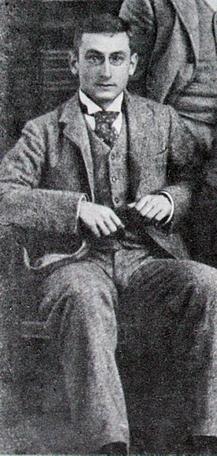Fourc.
| Henry Georges Fourcade | |
|---|---|
 |
|
| Born |
8 July 1865 Bordeaux, France |
| Died | 19 January 1948 (aged 82) Humansdorp, South Africa |
| Residence | France, Japan, South Africa |
| Fields | Surveying, forestry, photogrammetry, botany |
| Signature | |
Henry Georges Fourcade, also known as Henri Georges Fourcade and sometimes Georges Henri Fourcade, was a surveyor, forester, pioneer of photogrammetry and as botanist, a major early collector of the Southern Cape flora.
Henry Georges was born at 16, Rue de Treuils, Bordeaux, the son of Justin Jadé Fourcade and Marie Prat. He had one other sibling, his older sister Jeanne Marie. His father was a general storekeeper, who soon moved to Yokohama, Japan and became an importer of wines and liqueurs, where the family lived at No. 10 on the Bund or waterfront. When he was twelve, he returned to France to finish his secondary school education, obtaining a school-leaving certificate just after turning fourteen, winning the first prize in ethics, as well as a prize in physics and chemistry. The next year he attended technikon and obtained good results in English, French, German, arithmetic, chemistry and commerce. In late-1880, Mrs. Fourcade, for reasons unknown, set sail for Table Bay, in the Cape colony. She returned to France a year or two later, but her children remained in Cape Town. Henry Georges enrolled at the South African College, doing a course in the Theory of Land Surveying.
In July 1882, having just turned 17, Fourcade took up an appointment with the Cape Colony's Forestry Department, serving under its first Superintendent of Woods and Forests, Médéric de Vasselot de Régné, originally from the French National School of Forestry at Nancy. With de Vasselot, Fourcade studied forest science and management, acquiring knowledge about the climate, soils and indigenous trees.
De Vasselot boasted about the progress shown by his protégé and put Fourcade in charge of the departmental herbarium. A few months later, he was sent to Knysna, with the task of surveying and then sectioning the forest into manageable parts. He performed this job well, training the existing marksmen to comply with new regulations that had come into force and that were designed to make the forest sustainable. This early exposure to the practical side of sawmilling and forest management would become very valuable years later, when he had his own sawmilling business. In an era of indiscriminate felling of trees, he stressed the risks inherent in upsetting the balance of nature by felling one or two species of tree only, pointing out that such selective fellings would undermine the principle of removing mature growth to improve conditions for young growth in the forest. By 1886, the area sectioned under Fourcade amounted to 12 814 hectares, outperforming his colleagues. In his annual report, he proposed a few allotments to be allocated to bona fide wood-cutters near the then new Millwood goldfield.
...
Wikipedia

